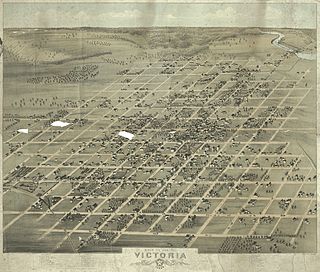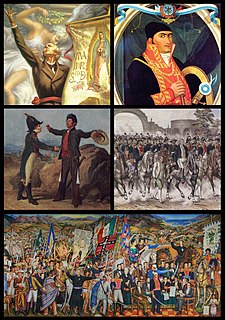
Goliad is a city in Goliad County, Texas, United States. It is known for the 1836 Goliad massacre during the Texas Revolution. It had a population of 1,908 at the 2010 census. Founded on the San Antonio River, it is the county seat of Goliad County. It is part of the Victoria, Texas, Metropolitan Statistical Area.

Martín Perfecto de Cos was a Mexican Army general and politician during the mid-19th century. Born in Veracruz, the son of an attorney, he became an army cadet at the age of 20, a lieutenant in 1821, and a brigadier general in 1833.

The Battle of Goliad was the second skirmish of the Texas Revolution. In the early-morning hours of October 9, 1835, Texas settlers attacked the Mexican Army soldiers garrisoned at Presidio La Bahía, a fort near the Mexican Texas settlement of Goliad. La Bahía lay halfway between the only other large garrison of Mexican soldiers and the then-important Texas port of Copano.
The Convention of 1832 was the first political gathering of colonists in Mexican Texas. Delegates sought reforms from the Mexican government and hoped to quell the widespread belief that settlers in Texas wished to secede from Mexico. The convention was the first in a series of unsuccessful attempts at political negotiation that eventually led to the Texas Revolution.
The DeWitt Colony was a settlement in Mexican Texas founded by Green DeWitt. From lands belonging to that colony, the present Texas counties of DeWitt, Guadalupe and Lavaca were created. The hub of the colony was primarily located, however, in what is now Gonzales County. The first battle of the Texas Revolution occurred in the DeWitt Colony.

The Battle of Lipantitlán, also known as the Battle of Nueces Crossing, was fought along the Nueces River on November 4, 1835 between the Mexican Army and Texian insurgents, as part of the Texas Revolution. After the Texian victory at the Battle of Goliad, only two Mexican garrisons remained in Texas, Fort Lipantitlán near San Patricio and the Alamo Mission at San Antonio de Béxar. Fearing that Lipantitlán could be used as a base for the Mexican army to retake Goliad and angry that two of his men were imprisoned there, Texian commander Philip Dimmitt ordered his adjutant, Captain Ira Westover, to capture the fort.
Philip Dimmitt (1801–1841) was an officer in the Texian Army during the Texas Revolution. Born in Kentucky, Dimmitt moved to Texas in 1823 and soon operated a series of trading posts. After learning that Mexican General Martín Perfecto de Cos was en route to Texas in the year 1835 (??) to quell the unrest, Dimmitt proposed that the general be kidnapped on his arrival at Copano. The plan was shelved when fighting broke out at Gonzales, but by early October, 1835, it had been resuscitated by a group of volunteers at Matamoros. Not knowing that Cos had already departed for San Antonio de Bexar, this group decided to corner Cos at Presidio La Bahia in Goliad. Dimmitt joined them en route, and participated in the battle of Goliad.

Agustín Viesca (1790–1845) was a governor of the Mexican state of Coahuila y Tejas in 1835. He was the brother of José María Viesca, also a governor of Coahuila y Tejas during 1827-1831.
Juan Jose Maria Erasmo Seguin was a prominent citizen and politician in San Antonio de Bexar in the 19th century. From 1807 until 1835, Seguin served as head postmaster of San Antonio, Texas. After Mexico achieved independence from Spain, Seguín was named the sole representative from Texas to the constitutional convention. He helped to draft the Constitution of 1824 and was a major influence in the addition of a general colonization provision. Seguín assisted Stephen F. Austin in choosing land for the first colony of American settlers to immigrate to Texas. He later supported the Texas Revolution, providing political as well as material support.
The Matamoros Expedition was a planned 1836 invasion of the Mexican port town of Matamoros by rebellious Texians. As the Mexican government transitioned from federalism to a centralized government in 1835, many federalists offered armed opposition. In Mexican Texas, settlers launched a full rebellion, known as the Texas Revolution, in October. By the end of the year, the Texians had expelled all Mexican soldiers from their territory. Confident that there would be no more fighting within their lands, Texans began looking for ways to extend the fight.
Plácido Benavides (1810–1837) was an early Mexican-born settler in De Leon's Colony, Victoria County, Texas. Benavides earned himself the sobriquet of the Paul Revere of Texas for his 1836 journey from San Patricio to Goliad to Victoria, warning residents of the approaching Mexican army. He was twice elected alcalde of Victoria, Texas. He married into the powerful De León family, and with his wife Agustina became the father of three daughters. Benavides fought against the dictatorship of Antonio López de Santa Anna, but did not feel Texas should be separated from Mexico.

De León's Colony was established in 1824 in northern Coahuila y Tejas state of the First Mexican Republic, by empresario Martín De León. It was the only ethnically Mexican colony founded during the Mexican period (1824-1835) that is located within the present-day U.S. state of Texas.
Carlos de la Garza (1807–1882) was a rancher in Goliad, Victoria and Refugio counties of Texas whose participation in the Battle of Coleto was instrumental in the surrender of James Fannin and the Texian forces.

The Goliad Declaration of Independence was signed on December 20, 1835 at Presidio La Bahía in Mexican Texas.













